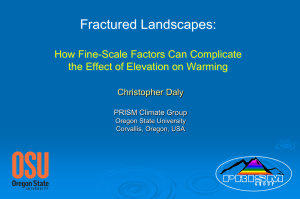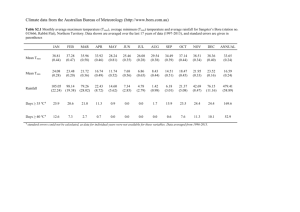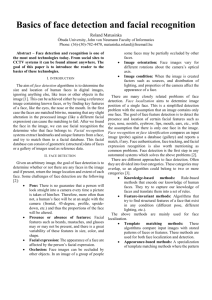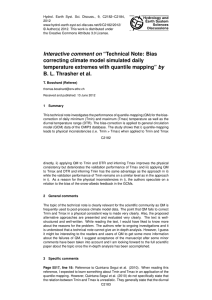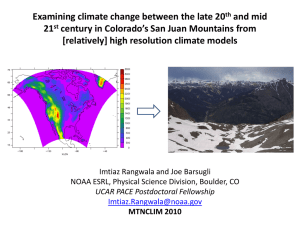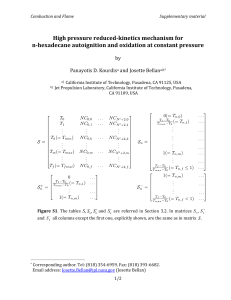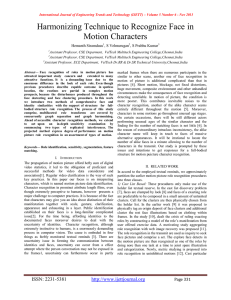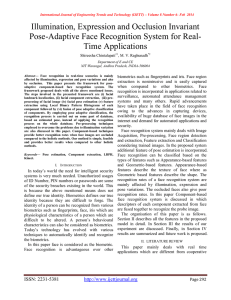A Method of Face Detection using Geometrical Structure
advertisement
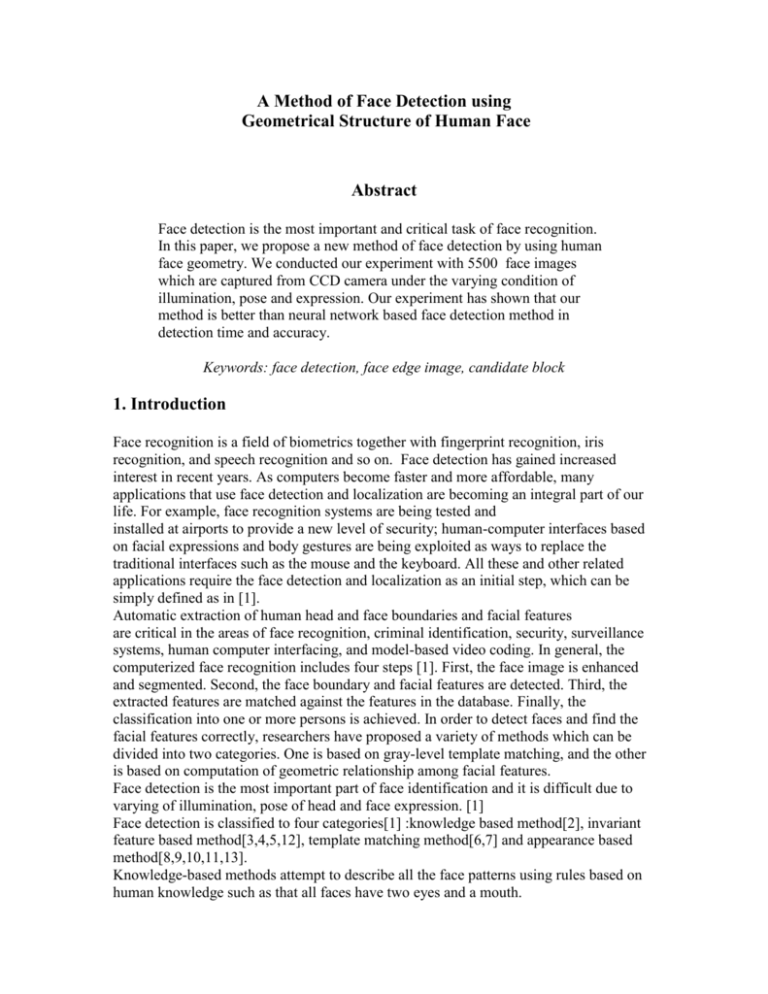
A Method of Face Detection using Geometrical Structure of Human Face Abstract Face detection is the most important and critical task of face recognition. In this paper, we propose a new method of face detection by using human face geometry. We conducted our experiment with 5500 face images which are captured from CCD camera under the varying condition of illumination, pose and expression. Our experiment has shown that our method is better than neural network based face detection method in detection time and accuracy. Keywords: face detection, face edge image, candidate block 1. Introduction Face recognition is a field of biometrics together with fingerprint recognition, iris recognition, and speech recognition and so on. Face detection has gained increased interest in recent years. As computers become faster and more affordable, many applications that use face detection and localization are becoming an integral part of our life. For example, face recognition systems are being tested and installed at airports to provide a new level of security; human-computer interfaces based on facial expressions and body gestures are being exploited as ways to replace the traditional interfaces such as the mouse and the keyboard. All these and other related applications require the face detection and localization as an initial step, which can be simply defined as in [1]. Automatic extraction of human head and face boundaries and facial features are critical in the areas of face recognition, criminal identification, security, surveillance systems, human computer interfacing, and model-based video coding. In general, the computerized face recognition includes four steps [1]. First, the face image is enhanced and segmented. Second, the face boundary and facial features are detected. Third, the extracted features are matched against the features in the database. Finally, the classification into one or more persons is achieved. In order to detect faces and find the facial features correctly, researchers have proposed a variety of methods which can be divided into two categories. One is based on gray-level template matching, and the other is based on computation of geometric relationship among facial features. Face detection is the most important part of face identification and it is difficult due to varying of illumination, pose of head and face expression. [1] Face detection is classified to four categories[1] :knowledge based method[2], invariant feature based method[3,4,5,12], template matching method[6,7] and appearance based method[8,9,10,11,13]. Knowledge-based methods attempt to describe all the face patterns using rules based on human knowledge such as that all faces have two eyes and a mouth. Template-based methods represent the face class by templates with allowable deformations which rely on the alignment of feature points. Feature invariant methods are hard to use in detecting faces in real images as it is difficult to find features that are truly invariant with respect to all faces and large perturbations in lighting, pose, and expressions. Appearance-based methods provide several key advantages and are widely used in face detection. Especially, as they allow one to learn the models from training data, the large amount of intra-class variation, expression, and pose can be accounted for in training by using a large training set. In this paper, we propose a new method of face detection using geometrical structure of human face. This paper is organized as follows. Section 2 describes the extraction of face edge image. Section 3 describes face geometry based on the face detection algorithm. Section 4 presents our experimental results in comparison with neural network based face detection method presented in [9]. Conclusions are made in Section 4. 2. Extraction of Face Edge Image This phase is a first part of preprocessing of face detection algorithm. Fig.1 shows block diagram of face edge image extraction. 2.1 Gray Normalization Given input gray image I (i, j ) , normalized image I (i, j ) is computed by the following equation. 2 V I (i, j ) M M 0 0 , I (i, j ) M V I (i, j ) 2 V0 I (i, j ) M , I (i, j ) M M 0 V where, M , V : mean and variance of inputted imager I (i, j ) M 0 , V0 : mean and variance of destination image I (i, j ) (1) 2.2 Edge detection In order to find face edge image, we apply 3 3 mask (see Fig.2) to median filtered and smoothed image. In this system, we assume that human head is up-straight in range of equation (3) (see Fig.3). Fig.3 shows camera-face interface condition of our system. 2.3 Adaptive binarization Given M I ,mean of edge detected image I (i, j ) , binary image I (i, j ) is computed by the following equation . I (i, j ) TB 0, (2) I (i, j ) 255, others where, TB M I * PB / 100 where, 0 x , y , z 15 0.3m l z 0.7 m (3) 2.4 Removing Noise In this phase, when the pixel number of black-connected blocks in white region are less than TS , we remove all them. For convenience, we call black-connected block to block briefly. 3. Face detection algorithm Fig.4 shows flowchart of our face detection algorithm. As shown in Fig-4, the input of our face detection algorithm is binary face edge image extracted above. - Extraction of candidate mouth block For any block of face edge image, if the following condition is satisfied, then we select it as candidate mouth block. xy xy Tmin y / x Tmax x x Tmin x Tmin where, (4) x, y : width and height of block, xy xy Tmin , Tmax : minimum and maximum of ratios of block width and height, x x Tmin , Tmax : minimum and maximum of width of block. - Extraction of candidate face region For any candidate mouth block extracted above, we calculate candidate face region according to human face geometry by referencing literature [14]. - Calculation of face score Here, we don’t discuss about face score calculation (See literature [14]). - Extraction of face orientation In our system, we extract the orientation of line that passes on center of mouth and is perpendicular to two eye connected line as face orientation.(See Fig.5) 4. Experimental results Thresholds of face detection algorithm used in our experiment are as follows. xy xy x x M 0 120, V0 70, PB 98, TS 60, Tmin 0.6, Tmax 1.0, Tmin 96, Tmax 200, Nm 50 We conducted our experiment with the 5500 data of face images which are captured from CCD camera (Logitech) under the varying condition of illumination, pose of head and expression of face, with the computer Pentium-III(CPU 650MHz, Memory 128MB). Table.1 shows the comparison result of detection time and detection rate between our method and proceeding method [9]. Item Method Method [9] Our method Mean Detection Time 82 ms 76 ms Mean Detection Rate 92.75% 94.25% Table.1 A comparison result of mean face detection time and mean detection rate 5. Conclusion In this paper, we have presented a new method of face detection by using human face geometry. Our study has shown that our method is better than the neural network based eye detection method in detection time and accuracy. The full face detection algorithm on face image of any pose, scale and illumination will be our future task. References [1] M. H. Yang et al, “Detecting Faces in Images : A Survey”, IEEE trans. on PAMI, 24(1), 34-59. [2] C. Yang et al, “Human face detection in complex background”, Pattern Recognition 27(1), 345-350.. [3] R. Kjeldsen et al, “Finding skin region in color images”, Proc. Second Intel’s Conf., Automatic Face and Gesture Recognition, 312-319. [4] T. K. Leung et al, “Finding faces in cluttered scenes using random labeled graph matching”, Proc. Fifth IEEE Int’l. Conf.,Computer Vision, 637-644. [5] Y. Dai et al,.“Face-texture model based on SGLD and its application in face detection”, Pattern Recognition 29(6), 1007-1017. [6] I. Craw et al,.“Finding face features”, Proc. second European Conf., Computer Vision, 92-96. [7] A. Lanitis et al,.“An automatic face identification system using flexible appreance models”, Image and Vision Computing 13(5), 393-401. [8] M. Turk et al,.“Eigenfaces for face recognition”, Recognitive Neuroscience 3(1), 7196. [9] H. Rowley et al,.“Neural network based face detection”, IEEE Trans. on PAMI. 20(1), 23-38. [10] H. Schneidermn et al, “Probabilistic modelling of local appreance and spatial relationships for object recognition”, Proc. IEEE Conf., Computer Vision and Pattern Recognition, 45-51. [11] H. Schneiderman et al, “A statistical method for 3d object detection applied to faces and cars”, In Proc. Computer Vision and Patt. Recog., 749–751, Hilton Head Island, SC, June 13-15, 2000. [12] P. Viola et al, “Robust real-time face detection”, In ICCV01, 747-749, 2001. [13] C. A. Waring, “An exploration of the spectral histogram representation for face detection”, Masters Thesis, Department of Computer Science, Florida State University, July, 2003. [14] J. S. Kim,.“The formation of human face”, Kyoukdoser Publisher, D. P. R. of Korea, 47-68, 2001.
